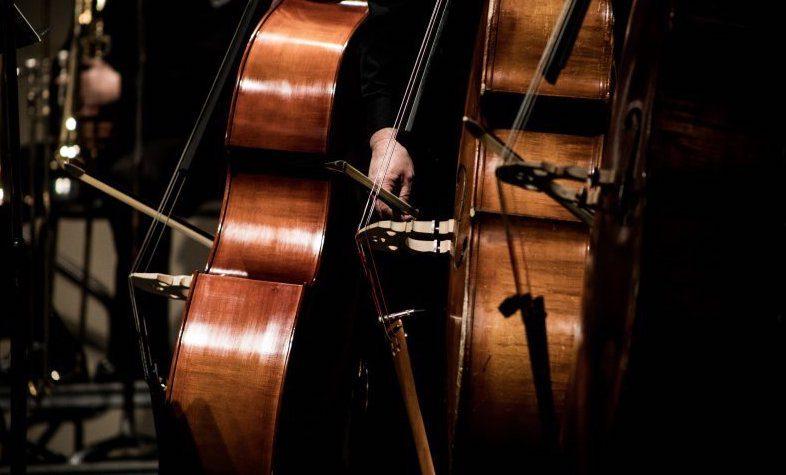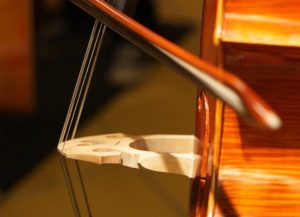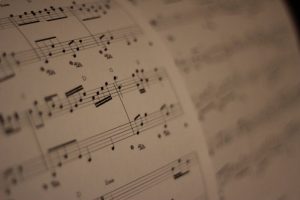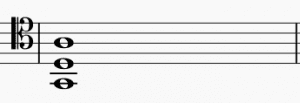Like many cellists, my music education began with learning to read classical notation at the same time I learned cello. Some of the best sounding musicians I meet learn their instruments completely by ear, and decide not to bother with sheet music. However, they limit themselves with this choice. Not only is the majority of cello repertoire based on classical sheet music, but they won’t be able to learn a new piece unless they hear it first. Reading sheet music can be confusing at first, but cellists can use a shortcut with our open strings to understand how classical notation represents cello notes.
Understanding The Five-Lined Staff
Classical sheet music notation uses a five-lined staff to show pitches based on a heptatonic (seven note) scale. As you move vertically up the staff, the pitch goes up. And likewise, it goes down as you move down the staff.
The staff itself doesn’t tell you the specific note names however, so always pay attention to the clef, located on the left side of every staff. A clef tells you which notes are represented on a musical staff using the type of clef and position on the staff. There are three types of clef: F-clef, C-clef, and G-clef. They get their names from the notes they are placed around, shown below.
These “note names” for the clefs are the general version, but they have more specific names depending on where the clefs are positioned on the staff, and on which instrument they were used for historically. For example, the G clef is also known as the treble clef, and the F-clef is known as the bass clef. Cellists also use a C-clef on the second line from the top, known specifically as a tenor clef.
The Low End of the String Family Has All Three Clefs in Their Sheet Music
The low end of the string family (cello and bass) has all three clefs in our sheet music. Not only do we read bass clef for our low range, we also learn treble clef for the highest notes and tenor clef for the connecting notes.
Cellists start reading sheet music using the bass clef, which fits all the notes in first position relatively close to the staff. The easiest way to find the cello notes in this clef is to know where your open strings are on the staff. A string is on the top line of the staff, D string is in the middle line, and the G string is the bottom line.
The open C string is two lines below the staff, which is marked using ledger lines. Ledger lines are like temporary additions to the staff for notes that go outside its range. Composers try to keep cello notes close to the staff so it is easier to read. When the notes get too high for bass clef, we switch to tenor clef. As we shift into upper neck positions which would need more and more ledger lines if kept in bass clef.
Tips for Reading Cello Notes in Different Clefs
Tenor
The easiest way to read the tenor clef is by shifting the open strings down one place from the bass clef. In tenor clef, open A string is now the middle line and D string is the bottom line. G string takes the place of C string, two ledger lines below the staff.
You can also think of tenor clef like the bass clef if you stay in fourth position. First finger in fourth position on the A string (e) is the top line, on the D string (a) is the middle line, and on the G string (D) is the bottom line.
Treble
Treble clef is usually saved for very high notes in thumb position. It is common to see the music go into treble clef at the highest part of a melody temporarily, before returning to bass or tenor clef. The open string cello notes don’t fit as neatly into this clef.
The only open string we can write practically is the A string. This is still two ledger lines below the staff. It is easier for cellists to learn treble clef notes using scales, because they repeat for each octave. So we don’t have to worry about the specific notes so much as continuing the pattern up and down. If you are playing in the high positions called for by treble clef, you probably understand how to read the cello notes in the lower positions fairly well.
Practice Scales to See Where Clefs Change
At that point, it is just a matter of giving a name to the symbol on the page. You can practice reading different clefs using basic scales. This will help you understand where the clef change usually occurs while working on your technique. Saint-Saens’ Le Cygne (The Swan) is a great piece to practice reading sheet music with changing clefs. Especially if you look at different editions. Some versions use a combination of bass and tenor clef. Some use only treble clef, and others use all three.
Learning to Read Sheet Music is Like Learning a Language
Learning to read sheet music is like learning to read any language, you must build your vocabulary first. Use the open strings as a starting point for your cello notes vocabulary, and you can practice reading notes above, below and between. With enough practice you will read sheet music as easily as you read this article.
William Crider






